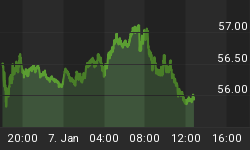The following is part of Pivotal Events that was published for our subscribers October 16, 2008.
SIGNS OF THE TIMES:
Early This Year:
"To be sure, a crash in the oil market is not imminent."
- Bloomberg, June 3, 2008
"OPEC has already done what OPEC can do, and oil prices will not come down."
- OPEC President Chakie Khelil, Breitbart,com, June 24, 2008
"Avoid Dollar at All Costs"
- Jim Rogers, Bloomberg, July 30, 2008
The amount of "at all costs" seems to be open-ended.
More Recent:
"Corporate Bonds Become Fund Managers' Favorite"
"Junk Bonds Look Attractive"
- Wall Street Journal, September 29, 2008
At the time, junk was yielding 18%. In two weeks it's down a disastrous 34 points and yielding 27%. The reason for the bullishness on junk was because the economy was slowing. But the research did not include disappearing liquidity typical of the post-bubble world.
"Investor Deleveraging Hits Junk"
- Wall Street Journal, October 1, 2008
It seems that ambitious policy makers have finally made a sow's ear out of a silk purse. The Washington Post had a headline: "The End of American Capitalism" Don't they and most interventionists wish, but more than likely the collapse is marking the eventual end of market rigging by a priesthood of philosopher kings. It really takes some mixed-metaphors to get across just how hazardous generations of arbitrary policy can become.
* * * * *
INTEREST RATES
Credit Spreads continue to widen at the long end. As noted in the front-page quotes the junk bond has sold off by some 32 points in the last two weeks.
In the almost carefree days of last October, junk was trading at an 11% yield. The full decline has been from 100 to 41, or 59 points. This is a disaster as it represents an enormous decline in an important asset class.
The financial markets have become a black hole sucking the prices of most asset classes down, and this could go on for some time. The July 11, 1932 edition of Barron's editorial included some interesting points: "The Federal Reserve policy of cheapening credit through the purchase of government bonds has been unable to make a dent in the conservatism of borrower or bank lender, in short, every anti-deflationary effort has yet to provide positive results. The depression is sucking more and more bonds into its vortex."
The key point is that the Fed had been providing liquidity by purchasing treasury bonds out of the market. The other point was that the effort wasn't having any results.
Why should it be any different this time around?
The Yield Curve (10s to 2s) continues to steepen and traders should could continue the position.
The Long Bond made the test of the 124 high with a rush to 122 a week ago. So far the drop has been to 113.3. There is support in the 112s and falling through this level will really move the bond revulsion into long treasuries.
As we have been emphasizing, the street has been buying the long bond as a "flight" to safety. This is just plain wrong - the real flight is and has been to bills.
The Dollar Index continues to firm with the panics and then it takes a little rest as the waves of selling abate.
That along with the unwinding of the great "long hot stories" and "short dollars" position provides the fundamentals on dollar strength.
Technically, the ChartWorks used the same analysis that was successful at the important low in December, 2004. The DX decline to 70.7 in March of this year registered a Downside Capitulation and the action completed with the Sequential Buy pattern. The decline to 71.3 in mid July completed an important test. What followed is the strength that we considered would be the worst thing that could happen to the financial markets as well as to policy makers.
Weekly RSI is getting interesting. If this rally is within the old bear market the swing in momentum is almost at the level that ends rallies. On the other hand, if this is the first leg of a long bull market momentum has further to run.
The next few weeks could see some remarkable financial violence.
The Canadian Dollar suffered a severe plunge from 97 on September 22 to 84 this week. Over time, we have found that the two main determinants on C$ weakness are declining commodities and widening corporate spreads.
All three have been evident. The range on the weekly RSI has been impressive from the high of 110 a year ago. Also in the market is that the Conservatives did not win a majority, but they did gain some sixteen seats.
This is a step towards stable government that could become solidly conservative. The Canadian dollar could find support in the low 80s.
The Baltic Index (BDI) continues to crash. The high was 11793 at the end of June and the drop to 1615 amounts to 86%. Beyond indicating that international trade is in decline, it bellows that shipping is in deep trouble.
With some big swings it took five years to get to the top and only two and a half months to give it all up.
Link to (DATE) 'Bob and Phil Show' on Howestreet.com:http://www.howestreet.com/index.php?pl=/goldradio/index.php/mediaplayer/994.
















